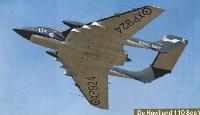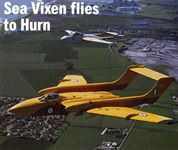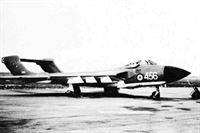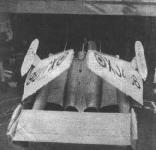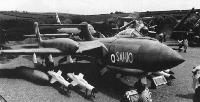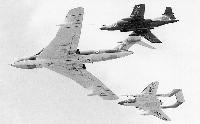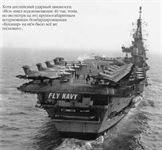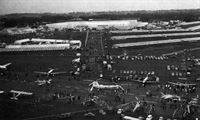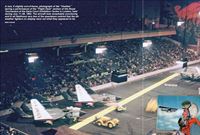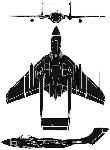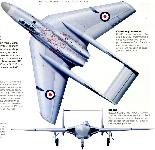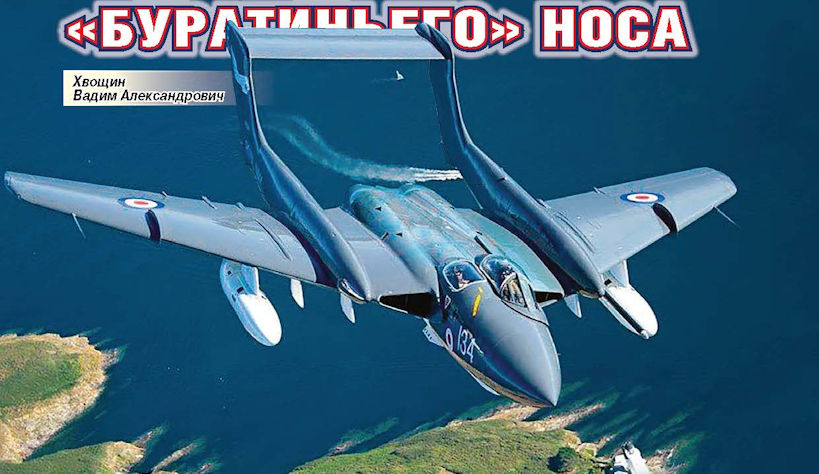
Описание
Страна : Великобритания
Год : 1951
Двухместный всепогодный палубный истребитель-штурмовик
de Havilland DH.110 Sea Vixen
Самолет DH.110 первоначально проектировался как всепогодный истребитель для британских ВВС, в тендере ему противостоял перехватчик Gloster Javelin с дельтовидным крылом. Прототип взлетел 26 сентября 1951 года, второй самолет присоединился к программе испытаний 25 июля 1952 года. Осенью 1954 года последний самолет прошел испытания "посадка с уходом на второй круг" на авианосце "Альбион". Первый флотский заказ на самолет, названный DH.110 Sea Vixen, был размещен в январе 1955 года. Заводу компании "de Havilland" в Кристчёрч поручили программу разработки и производства. Модернизированный под требования ВМС прототип совершил первый полет 20 июня 1955 года, а 5 апреля 1956 года он впервые произвел посадку с использованием аэрофинишера на палубу авианосца "Арк Ройал".
Первый самолет из начального заказа в 45 всепогодных истребителей Sea Vixen FAW.Mk 1 получил откидывающийся на шарнире заостренный носовой обтекатель, складывающиеся с помощью силового привода консоли крыла, и гидравлически управляемое носовое колесо. Этот самолет впервые взлетел 20 марта 1957 года. После эксплуатационных испытаний в ноябре 1958 года в звене "Y" 700-й эскадрильи на борту британских авианосцев "Викториес" и "Центавр" машина поступила на вооружение 892-й эскадрильи, сформированной в Йеовилтоне 2 июля 1959 года и отправленной в море на борту авианосца "Арк Ройал" в марте 1960 года.
Вариант
DH.110 Sea Vixen FAW.Mk 2: усовершенствованная версия с дополнительным запасом топлива в районе передних секций хвостовых балок, продленных в область крыла, и с возможностью подвески четырех УР Red Top класса "воздух-воздух" малой дальности вместо ракет Firestreak на версии Mk 1; два опытных самолета, переделанные из стандартной версии Mk 1, взлетели 1 июня и 17 августа 1962 года. Позднее их довели до полного стандарта Sea Vixen FAW.Mk 2; 14 самолетов версии Mk 1 довели до стандарта Mk 2 на заводе. Первый из них полетел 8 марта 1963 года. Еще 15 самолетов построили заново. Весь этот парк из 31 самолета дополнили затем 67 переделанными машинами версии Mk 1. Вариант Sea Vixen FAW.Mk 2 поступил на вооружение 899-й эскадрильи в декабре 1963 года. Спустя год эта часть попала на борт авианосца "Игл" и находилась в составе его авиагруппы до списания корабля в 1972 году.
ТАКТИКО-ТЕХНИЧЕСКИЕ ХАРАКТЕРИСТИКИ
de Havilland DH.110 Sea Vixen (Sea Vixen FAW.Mk 2)
Тип: двухместный всепогодный палубный истребитель-штурмовик
Силовая установка: два ТРД Rolls-Royce Avon Mk 208 тягой no 49,95 кН
Летные характеристики: максимальная скорость 1110 км/ч на уровне моря; набор высоты 3050 м - за 1 минуту 30 секунд; практический потолок 21790 м
Масса: максимальная взлетная 18858 кг
Размеры: размах крыла 15,54 м; длина 17,02 м; высота 3,28 м; площадь крыла 60,20 м1
Вооружение: четыре УР Red Top "воздух-воздух" малой дальности и два убираемых в носовую часть блока по 14 НАР калибра 51 мм, плюс до 907 кг полезной нагрузки на четырех подкрыльевых узлах подвески
- Описание
Фотографии
-
Мировая Авиация 44
Регистрационный номер: WG236 [10] DH.110 (первый прототип). DH.110, сконструированный согласно той же спецификации, что и Javelin компании "Gloster", являлся двухместным всепогодным истребителем для Королевских ВВС и ВМС. Имеющий в основе ту же конструкцию, что и Vampire и Venom, новый самолет отличался крылом большой стреловидности и оснащался двумя двигателями Rolls-Royce Avon. Британские ВВС выбрали Javelin, в то время как Sea Vixen и DH.110 долго и эффективно эксплуатировался в авиации ВМС.
-
Мировая Авиация 106
В 1968 году была сформирована пилотажная группа "Simon's Circus" с пятью самолетами Sea Vixen FAW.Mk 2 из 892-й эскадрильи. Машины этого типа также были на вооружении 893-й и 899-й эскадрилий.
-
Air Enthusiast 1999-03 / S.Hazell - Twin-tailed target
Регистрационный номер: XS587 [3], G-VIXN [3] Sea Vixen ‘FAW.2(TT)’ XS587, Royal Aircraft Establishment, Llanbedr, 1982.
-
Air Enthusiast 1999-03 / S.Hazell - Twin-tailed target
Регистрационный номер: XJ524 [3] Sea Vixen 'FAW.2(TT)' XJ524, Flight Refuelling Ltd, Hurn, 1983.
-
Air Enthusiast 1999-03 / S.Hazell - Twin-tailed target
Регистрационный номер: XP924 [13], G-CVIX [13] Sea Vixen D3 second prototype XP924, Royal Aircraft Establishment, Llanbedr, July 1989.
-
Авиация и Космонавтика 2013-12 / Р.Вениаминов - "Рамы" небесные /Фотоархив/ (2)
Регистрационный номер: XP924 [13], G-CVIX [13] De Havilland 110 Sea Vixen
-
Авиация и Космонавтика 2025-02 / В.Хвощин - Видеть дальше "буратиньего носа" (4)
Регистрационный номер: XS576 Максимально сдвинутый к левому борту фонарь самолета de Havilland D.H.110 «Sea Vixen» FAW.2 с бортовыми номерами «XS576/E-125» из лондонского Имперского военного музея. От других модификаций его отличает увеличенный запас топлива (установка дополнительных баков в хвостовом оперении) и способность запуска с подкрыльевых пилонов ракет малой дальности класса «воздух-воздух» Hawker Siddeley «Red Top» с инфракрасной головкой самонаведения. До поступления на хранение в музей эта машина из состава 899-й эскадрильи военно-воздушных сил Королевского флота проходила службу на борту авианосца HMS «Eagle»
-
Aeroplane Monthly 1999-06 / J.Maynard - Spring-cleaning the hall /Mosquito aircraft museum/
Регистрационный номер: XJ565 Sea Venom FAW.22 XG730 shows off by waving its wings at slumbering Sea Vixen FAW.2 XJ565.
Другие самолёты на фотографии: De Havilland Venom / D.H.112 - Великобритания - 1949
-
Air Enthusiast 1999-03 / S.Hazell - Twin-tailed target
Регистрационный номер: XJ524 [3] Flight Refuelling Ltd’s target-tug XJ524 trailing a banner target from a winch unit carried on the port wing outer pylon. Unlike the other target-tug conversion this aircraft retained the operational black hatch cover to the observer’s cockpit.
-
Мировая Авиация 173
Последние Sea Vixen - буксировщики мишеней. Последние оставшиеся в эксплуатации Sea Vixen были переоборудованы в беспилотные мишени - вариант переоборудования FAW.Mk 2 в U.Mk 3 (затем D.Mk 3) был предложен авиационным научно-исследовательским центром в Фарнборо в начале 1970-х годов. К тому времени беспилотные мишени Meteor, дислоцированные в Лланбедре и привлекавшиеся к учениям на полигоне Аберпорт, уже устарели и требовали скорейшей замены. Программу одобрили, работы поручили компании "Flight Refuelling Ltd". Перед поставкой на предприятие компании в Тарант-Раштон с самолетов Sea Vixen демонтировали все вооружение и лишнее оборудование, включая РЛС, а специалисты "Flight Refuelling Ltd" устанавливали на самолеты систему дистанционного управления, позволявшую управлять полетом мишени с земли или с другого самолета, но возможность пилотирования машины летчиком сохранялась. Также устанавливалась аппаратура, позволявшая фиксировать промахи при испытании новых образцов вооружения. НИЦ в Фарнборо приступил к подготовке первых машин под переоборудование в беспилотные мишени в 1972 году, но только в 1975 году компания "Flight Refuelling Ltd" смогла приступить к реальному переоборудованию самолетов - к 1980 году, когда завод в Тарант-Раштон был закрыт, переоборудование прошел всего один самолет. После этого работы передали заводу той же компании в районе Борнмут-Хёрн, но к 1983 году у британского Минобороны возникли сомнения насчет необходимости переоборудования Sea Vixen в беспилотные мишени. Причем официально тактико-технические требования на беспилотную мишень на базе Sea Vixen выпущены не были, а проект постоянно испытывал недофинансирование. В конечном итоге в 1983 году проект приостановили, а в 1984 году - отменили вовсе. К тому времени были подготовлены три опытных Sea Vixen D.Mk 3, их передали в Лланбедр - впоследствии они использовались в различных испытаниях. В 1991 году последний летный экземпляр, XP924 (на фото), был отправлен на хранение - так завершилась карьера Sea Vixen. Самолет избежал участи многих, не отправился под нож и в 1996 году прибыл в аэропорт Суонси, где компания "de Havilland Aviation Ltd" восстановила его. В мае 2000 года самолет, с регистрацией G-CVIX и в красно-желтой окраске, вновь вернулся в небо.
-
Aeroplane Monthly 2000-08 / News
Регистрационный номер: XP924 [13], G-CVIX [13] Sea Vixen XP924 airborne in company with Vampire XE920 on May 19, 2000.
Другие самолёты на фотографии: De Havilland Vampire T / Vampire NF / D.H.113 / D.H.115 - Великобритания - 1950
-
Air Enthusiast 1999-03 / S.Hazell - Twin-tailed target
Регистрационный номер: XS587 [3], G-VIXN [3] FAW.2(TT) XS587 was saved from the scrap yard when it was bought at auction for display at Charlwood, Surrey, in 1990. It still carried the civil registration G-VIXN which had been reserved in 1985 when there were plans to restore the aircraft to flying condition.
-
Air Enthusiast 1999-03 / S.Hazell - Twin-tailed target
Регистрационный номер: XP924 [13], G-CVIX [13] XP924 at RNAS Yeovilton in July 1982 making one of its rare public appearances. At the time it was probably based at RAE Llanbedr but seems to have undertaken test flying from Hurn as well. The upper surface colour, although officially described as deep cream was more a bright yellow.
-
Aeroplane Monthly 1996-08 / M.Oakey - Vintage news
Регистрационный номер: XP924 [13], G-CVIX [13] Sea Vixen XP924 is due to fly to Swansea on July 12, 1996.
-
Aeroplane Monthly 1997-02 / M.Oakey - Vintage news
Регистрационный номер: XP924 [13], G-CVIX [13] Marcus Edwards taxying Sea Vixen XP924.
-
Air Enthusiast 1999-03 / S.Hazell - Twin-tailed target
Регистрационный номер: XN652 The first ‘production’ D.3 XN652, was never completed. It was photographed stored at Hurn in September 1985.
-
Aeroplane Monthly 2000-07 / News
Регистрационный номер: XP924 [13], G-CVIX [13] Sea Vixen XP924 undergoing engine tests at Swansea Airport on May 13, 2000.
-
Air International 1991-06 / Talkback
Регистрационный номер: XS577 One of the last de Havilland Sea Vixens still in official use is XS577 which was photographed in May at RAE Llanbedr by Mr G Stockle.
-
Air Enthusiast 1999-07 / I.Black - On Target!
Регистрационный номер: XP924 [13], G-CVIX [13] A view inside the main hangar with Sea Vixen D.3 XP924 in the foreground. This aircraft is now G-CVIX with de Havilland Aviation at Swansea.
-
Air Enthusiast 1999-03 / S.Hazell - Twin-tailed target
Регистрационный номер: XP924 [13], G-CVIX [13] D.3 XP924 (alias G-CVIX) inside the de Havilland Aviation hangar at Swansea. DHA is working towards putting the Vixen back into the air, perhaps by the year 2000.
-
Air Enthusiast 1999-03 / S.Hazell - Twin-tailed target
Регистрационный номер: XP924 [13], G-CVIX [13] View of the cockpit area of XP924.
-
Air Enthusiast 1999-03 / S.Hazell - Twin-tailed target
Регистрационный номер: XP924 [13], G-CVIX [13] The observer’s ‘dustbin’ on D.3 XP924.
-
Air Enthusiast 1999-03 / S.Hazell - Twin-tailed target
Регистрационный номер: XP924 [13], G-CVIX [13] XP924’s port engine bay details.
-
Aeroplane Monthly 1981-06 / B.Rivas, A.Bullen - John Derry /Test Pilot Profile/ (3)
Регистрационный номер: WG236 [10] View of the prototype D.H.110, WG236, first flown by John Cunningham on September 26, 1951. Derry and Richards were to lose their lives in this aircraft a year later.
-
Aeroplane Monthly 1994-12 / J.Maynard - John Cunningham (4)
Регистрационный номер: WG236 [10] WG236, the prototype D.H.110, first flown by John Cunningham on September 26, 1951. John Derry and Tony Richards lost their lives in the same aircraft over Farnborough on September 6, 1952.
-
Aeroplane Monthly 1981-06 / B.Rivas, A.Bullen - John Derry /Test Pilot Profile/ (3)
Регистрационный номер: WG236 [10] View of the prototype D.H.110, WG236, first flown by John Cunningham on September 26, 1951. Derry and Richards were to lose their lives in this aircraft a year later.
-
Мировая Авиация 60
Регистрационный номер: WG236 [10] 26 сентября 1951г.: в воздух поднялся DH. 110, планировавшийся как всепогодный истребитель корабельного базирования, но затем доработанный под требования от 1948 года к ночному истребителю британских ВВС.
-
Мировая Авиация 44
Регистрационный номер: WG236 [10] Форма крыла DН.110 во многом была скопирована с экспериментального DН.108, который первым из британских самолетов достиг скорости 1M. Серьезная конструктивная слабость крыла привела к тому, что DН.110 развалился в полете.
-
Aeroplane Monthly 1981-06 / B.Rivas, A.Bullen - John Derry /Test Pilot Profile/ (3)
Регистрационный номер: WG240 [5] The second prototype D.H.110, WG240, as seen at the 1952 SBAC Farnborough Show.
-
Мировая Авиация 173
Регистрационный номер: WG240 [5] Опытный DH.110, WG240, в 1953 году был переделан в самолет-демонстратор и получил заметную черную окраску - машина испытывалась британскими ВМС, а затем была возвращена разработчику для дальнейшей работы.
-
Aeroplane Monthly 1980-06
Регистрационный номер: WG240 [5] The second prototype de Havilland D.H.110, WG240 was photographed by CHARLES SIMS of The Aeroplane in 1954, shortly before its appearance at that year's Farnborough Air Show.
-
Air Pictorial 1955-10 / J.Stevens - Farnborough 1955
Регистрационный номер: XF828 [5] Third prototype of the de Havilland D.H.110.
-
Air Pictorial 1956-05
Регистрационный номер: XF828 [5] Fleet Air Arm's most powerful two-seat, carrier strike fighter, the Christchurch-built De Havilland D.H.110 will shortly undergo deck land ing and take-off acceptance trials. The view shows the massive "Barn Door" air brake. The calibration nose probe is for test purposes. Illustrated is the third prototype XF828, a Mk.20X (semi-navalised).
-
Мировая Авиация 173
Регистрационный номер: XF828 [5] DH.110Mk 20Х, XF828, стал первым "почти оморяченным" опытным DH.110, его использовали для первых испытаний на авианосце "Арк Ройял" в 1956 году. Самолет был оснащен двигателями Avon 208, новым шасси, посадочным гаком и креплением для установки на катапульту.
-
Air Pictorial 1956-02
Регистрационный номер: XF828 [5] Still unnamed, the de Havilland D.H.110 has been accepted by the Royal Navy as a two-seat, all-weather strike fighter for carrier operations. This view shows the temporary nose probe, as well as the new one-piece dive brake under the fuselage, in line with the wing root. The leading-edge devices are carriers for stores.
-
Air Enthusiast 1999-03 / S.Hazell - Twin-tailed target
Регистрационный номер: WG240 [5] A view of the second prototype DH.110 showing the twin tails. This layout did not help the type’s transition to a drone.
-
Air Pictorial 1956-11
NEEDLE NOSES. To test the "needle sharp" pointed radome for the production de Havilland D.H.110 Mk. 20X a D.H.113 Vampire NF. Mk. 10 was modified accordingly. The resulting shape was then adapted to the D.H.110 Mk. 20X (photo). Because this front view was taken slightly to starboard, the nose of the Mk. 20X appears to be asymmetrical, an illusion which is further enhanced by the offset-to-starboard pilot's canopy. The nose probe is used for test purposes and will not appear on production D.H.110s which will shortly enter service with the Fleet Air Arm.
-
Air Pictorial 1957-10 / J.Stevens - S.B.A.C. 1957
Firestreaks under port wing of Sea Vixen F(AW). Mk. 20;
-
Air Pictorial 1956-09 / J.Stevens - Farnborough 1956
Underwing weapon pylons; a new radome to prevent excessive rain erosion are sported by the Hatfield-constructed D.H.110.
-
Air Pictorial 1957-10 / J.Stevens - S.B.A.C. 1957
Регистрационный номер: XJ475 [2] De Havilland Sea Vixen F(AW). Mk. 20 (XJ475; second production model). with six wing pylon mountings;
-
Air Enthusiast 1999-03 / S.Hazell - Twin-tailed target
Регистрационный номер: XJ482 Early production FAW.1 XJ482 was used by FRL as the ground rig for the drone control systems. Today it is part of the Norfolk and Suffolk Aviation Museum at Flixton.
-
Air-Britain Aeromilitaria 1984-01
Naval visitors to the forward airfield during August included Sea Vixen FAW.1 of 893.
-
Air Pictorial 1956-10 / J.Stevens - Farnborough Round-up
Регистрационный номер: XF828 [5] D.H.110 Mk. 20 (XF828), finished in new Royal Navy colours of dark sea-grey with white undersides. Tiny tail skids retract in flight.
-
Aviation Historian 21 / M.Willis - Here come the Vixettes
Регистрационный номер: XJ490 The genuine article - a pair of early production Sea Vixens take off in formation, the nearest, XJ490, carrying four Firestreaks on its underwing hardpoints, the furthest toting a pair of auxiliary fuel tanks. The Sea Vixen entered operational service with No 892 Sqn in July 1959, the Sea Venom leaving front-line service in 1960.
-
Jane's All the World Aircraft 1964 / 01 - Aircraft
Hawker Siddeley Sea Vixen F (AW) Mk.1 carrying a flight refuelling "buddy pack" under its starboard wing
-
Мировая Авиация 173
Регистрационный номер: XJ525 Этот XJ525 - один из 16 самолетов первой серии, поставки которых осуществлялись вслед за 27 предсерийной машиной. В общей сложности было поставлено 119 самолетов варианта Mk 1, 67 из них затем довели до стандарта Mk 2 - еще 29 самолетов FAW.Mk 2 были построены заново. Данный самолет несет пару ПТБ на 682 л и одну УР класса "воздух-воздух" Firestreak.
-
Air Pictorial 1961-10 / P.Greenhayes - Farnborough Comment
Регистрационный номер: XJ602 [2], XJ606 Two Sea Vixens demonstrate the Flight Refuelling "buddy" system.
-
Aviation Historian 38 / P.Stoddard - Sharpening the Scimitar
Регистрационный номер: XJ487, XJ493 Developed concurrently with the Scimitar, the D.H.110 Sea Vixen all-weather fighter was similarly powered by a pair of Rolls-Royce Avon engines, the type entering front-line service with No 892 Sqn in July 1959. The lead aircraft in this quartet of No 892 Sea Vixen FAW.1s is fitted with four de Havilland Firestreak air-to-air missiles.
-
Air Enthusiast 1999-03 / S.Hazell - Twin-tailed target
Регистрационный номер: XJ488 FAW.1 XJ488 on September 28, 1965, evaluating a winch unit and towed-target mounted below the port wing and counter-balanced by a drop tank below the starboard. The aircraft was never a dedicated target-tug but spent its whole career on development flying for various agencies, being heavily involved with Sea Vixen in-flight refuelling trials at various times.
-
Мировая Авиация 173
Регистрационный номер: XN649 [2] Sea Vixen использовался и для нанесения ударов по наземным целям, для чего вооружался НАР калибров 50,8 мм или 76,2 мм - как на этом FAW.Mk 1.
-
Мировая Авиация 173
890-я эскадрилья стала второй в авиации британских ВМС, получившей Sea Vixen. В 1956 году она недолго летала на Sea Venom, но всего четыре месяца спустя была расформирована - произошли две катастрофы, погибли два экипажа, включая командира эскадрильи. Служба с Sea Vixen оказалась для эскадрильи более продуктивной - она длилась 71 лет. На фотографии - самолет эскадрильи облетает авианосец "Гермес" (начало 1960-х годов).
-
Jane's All the World Aircraft 1980 / Encyclopedia of Aviation - Aircraft A-Z - v3
Регистрационный номер: XJ474 Самолет с кодом XJ474 в 1957 году прошел палубные испытания в испытательной эскадрилье британских ВМС и стал первой машиной, которую довели до серийного стандарта.
-
Мировая Авиация 173
Отличительной особенностью предназначенной для корабельного базирования машины стал каплевидный фонарь кабины пилота - это давало хороший обзор вперед, даже несмотря на длинный носовой обтекатель антенны РЛС. Стартующий с катапульты самолет несет код "V" - это знак авиагруппы авианосца "Викториес".
-
Air Pictorial 1956-06
The D.H.110, the most advanced all-weather interceptor yet to be ordered for the Royal Navy, is in production by the de Havilland Aircraft Company Ltd.
-
Air Pictorial 1957-10 / J.Stevens - S.B.A.C. 1957
Регистрационный номер: XJ475 [2] The Sea Vixen F(AW). Mk. 20, with underwing stores removed for the flying display.
-
Авиация и Космонавтика 2001-07 / М.Никольский - Развитие авиации корабельного базирования после Второй мировой войны
Регистрационный номер: XJ486 "Си Виксен"
-
Aeroplane Monthly 1989-12 / M.Oakey - Grapevine
Регистрационный номер: XJ841 De Havilland Sea Vixen FAW.1 XJ841 is the flagship of the fast-growing RNAY Fleetlands Museum.
-
Jane's All the World Aircraft 1966 / 02 - Aircraft
Hawker Siddeley Sea Vixen F(AW) Mk 2 of No. 899 Squadron
-
Aeroplane Monthly 1986-01 / 1986 UK Aircraft Collections and Museums Guide
Регистрационный номер: XN647 Sea Vixen FAW.2 XN647.
-
Air International 1989-01 / J.Fricker - EFA's Great Radar Contest (1)
Naval equivalent of the RRE-developed Al Mk 17 is GEC’s Al Mk 18 installed in the de Havilland Sea Vixen.
-
Мировая Авиация 173
Регистрационный номер: XN684 В 1961 году два Sea Vixen FAW.Mk 1, только что покинувших завод в Кристчерче (XN684 и XN685), были передислоцированы в Хэтфилд и переоборудованы под стандарт FAW.Mk 2. После изучения процедуры переоборудования обе машины приняли участие в отработке УР "воздух-воздух" Red Тор. На фотографии - XN684 несет четыре УР и оснащен специальной камерой для фиксации результатов испытаний в носовой части.
Hawker Siddeley Sea Vixen F.(AW) Mk.2 armed with four Red Top missiles -
Мировая Авиация 173
Регистрационный номер: XJ578, XN649 [2] Самолеты Sea Vixen Mk 1 из 899-й эскадрильи демонстрируют возможность дозаправки друг друга при помощи дополнительно установленной системы. Топливный бак с агрегатом для дозаправки другого самолета всегда подвешивался на внешнем пилоне под правой консолью крыла и уравновешивался простым ПТБ под левой консолью. На левой консоли крыла имелась фиксированная штанга для приема топлива в воздухе.
-
Aviation Historian 7
Er, that's the wrong way round, shurely? "Shorty" Hamilton refuels a Victor tanker from his Sea Vixen in April 1962
Другие самолёты на фотографии: Vickers Valiant - Великобритания - 1951
-
Мировая Авиация 164
Регистрационный номер: XJ584 Самолеты-заправщики существенно повысили боевой потенциал авиации британских ВМС. На фотографии: Victor K.Mk 1A из 57-й эскадрильи передает топливо на Buccaneer S.Mk 2 из 801-й эскадрильи и Sea Vixen FAW.Mk 2 из 893-й эскадрильи (обе приписаны к авиагруппе авианосца "Викториес").
Другие самолёты на фотографии: Blackburn Buccaneer / B-103 - Великобритания - 1958Handley Page Victor / H.P.80 - Великобритания - 1952
-
Aeroplane Monthly 1993-03 / R.Williams - The whistling wheelbarrow (3)
Argosy XN814 being used for Buddy Tanker trials with a Sea Vixen in 1965.
Другие самолёты на фотографии: Armstrong Whitworth Argosy / A.W.650 - Великобритания - 1959
-
Air Pictorial 1968-11 / J.Rawlings - Navy Days at Farnborough
Регистрационный номер: XJ604 [2] "Simon's Sircus Singleton." Sea Vixen FAW.2 XJ604 is one of six comprising No. 892 Squadron's heavyweight team
-
Air Enthusiast 1999-03 / S.Hazell - Twin-tailed target
Регистрационный номер: XJ524 [3] XJ524 flying with a Rushton winch and high-speed target fitted below the starboard wing, where it was visible from the observer’s position. The winch and target are counter-balanced by a drop tank and what appears to be an inert Firestreak guided missile below the port wing. Also visible is the tailplane trim tab, which was painted yellow.
-
Aviation Historian 15 / G.Ellis - Brothers in Arms
Big aeroplane, (comparatively) small carrier - a pair of Scimitars stand on the prow of HMS Eagle in 1968, alongside a Blackburn Buccaneer S.1 and a Fairey Gannet AEW.3, with Sea Vixens ranged aft. Even the largest of the Royal Navy’s carriers had shorter flight decks than those of their "small” Essex-class American counterparts.
Unknown to the Rhodesians, HMS Eagle was stationed off the coast of Tanzania in late November 1965. Seen here aboard Eagle in 1968 are Supermarine Scimitars, Blackburn Buccaneers, a Fairey Gannet AEW.3, de Havilland Sea Vixens and a Westland Wessex.Другие самолёты на фотографии: Blackburn Buccaneer / B-103 - Великобритания - 1958Fairey Gannet AEW - Великобритания - 1958Supermarine Scimitar - Великобритания - 1956Westland Wessex - Великобритания - 1958
-
История Авиации 37 / П.Каминский - Брошенный меч империи /Не вставшие в строй/ (1)
Регистрационный номер: XN683 Хотя английский ударный авианосец "Игл" имел водоизмещение 46 тыс. тонн, но несмотря на это крупногабаритным штурмовикам-бомбардировщикам "Буканир" на нём было всё же тесновато...
Другие самолёты на фотографии: Blackburn Buccaneer / B-103 - Великобритания - 1958
-
Air Pictorial 1991-10 / R.Macintyre - A South Pacific Symbiosis
Регистрационный номер: G-VIXN [3], XS587 [3] Sea Vixen G-VIXN with folded wings.
-
Air International 1981-02
Photograph taken by Mr Eftos on the offshore island of Sentosa of a Hawker Siddeley Sea Vixen F(AW) Mk.2, with a make-shift cockpit canopy
-
Air Pictorial 1968-11 / J.Rawlings - Navy Days at Farnborough
The Show is on. "Simon's Sircus" (Vixens) pull up into a smoking loop, while "Phoenix Five" (Buccaneers) depart to port.
Другие самолёты на фотографии: Blackburn Buccaneer / B-103 - Великобритания - 1958
-
Air Pictorial 1968-11 / J.Rawlings - Navy Days at Farnborough
The aerial armada sets off for Farnborough
Другие самолёты на фотографии: Blackburn Buccaneer / B-103 - Великобритания - 1958
-
Air International 1994-10 / P.Cooper - Forever Farnborough (2)
General view of the SBAC area seen during September 1960 showing, among others, the Gnat, Sea Vixen, Belvedere, Heron, Jet Provost, Comet, EP-9, Scout, Wasp, Whirlwind and Wessex. Note the exhibition area and the chalets, and compare with the area covered by these today.
Другие самолёты на фотографии: Bristol Belvedere / Type 192 - Великобритания - 1958De Havilland Comet 3 / 4 - Великобритания - 1954De Havilland Heron / D.H.114 - Великобритания - 1950Folland Gnat - Великобритания - 1955Hunting Percival Jet Provost / P.84 - Великобритания - 1954Percival E.P.9 - Великобритания - 1955Westland Wasp / Scout - Великобритания - 1958Westland Wessex - Великобритания - 1958Westland Whirlwind - Великобритания - 1953
-
Air Enthusiast 1999-03 / S.Hazell - Twin-tailed target
Регистрационный номер: XP924 [13], G-CVIX [13] Cockpit details of D.3 XP924 at Swansea.
-
Aeroplane Monthly 1983-11 / Personal album
Регистрационный номер: XS584 The two photographs were taken on HMS Eagle on June 15,1966. Sea Vixen FAW.2 XS584 of No 899 Sq FAA could not lower its starboard main wheel. The barrier, which could be rigged in two minutes flat, was put up and the Sea Vixen landed safely, demolishing the barrier in the process. Though the crew escaped injury they were both killed in a later accident.
-
Мировая Авиация 44
Регистрационный номер: WG236 [10] После выхода DН.110 из разворота концевые части крыла отвалились, из-за чего самолет резко задрал носовую часть. Через доли секунды носовая часть отломилась, Дерри и Ричардс оказались прижатыми к сиденьям, не имея возможности покинуть кабину из-за сильной перегрузки.
-
Aeroplane Monthly 1994-12 / J.Maynard - John Cunningham (4)
Регистрационный номер: WG236 [10] В сентябре 1952г. на авиасалоне в Фарнборо разбился прототип сверхзвукового истребителя-бомбардировщика D.H.110 "Виксен".
John Derry and flight test observer Tony Richards died very publicly at Farnborough on September 6, 1952, when the D.H.110 prototype WG236 broke up in the air. Spectator Herbert Orr's astonishing photograph shows the main portion of the aircraft hitting the ground. -
Мировая Авиация 44
Регистрационный номер: WG236 [10] Шоу продолжалось и после катастрофы. На снимке - самолет Bristol Britannia выруливает среди обломков. Спустя несколько минут летчик-испытатель самолета Hawker Невилл Дьюк совершил удачное пикирование на сверхзвуковой скорости над публикой в память о погибших коллегах.
Другие самолёты на фотографии: Bristol Britannia / Type 175 - Великобритания - 1952
-
Aeroplane Monthly 1981-06 / B.Rivas, A.Bullen - John Derry /Test Pilot Profile/ (3)
Регистрационный номер: WG236 [10] The wreckage of WG236’s centre section which glided down inverted to crash into a mobile radar generator. Massive steel reinforcing strips 12 to 14ft long can be seen on the outer surface of the starboard boom. These were attached after cracks had developed around tail boom components due to lack of stiffness, flutter or aeroelasticity problems.
-
Air Enthusiast 1999-03 / S.Hazell - Twin-tailed target
Регистрационный номер: XN657 Mortal remains of the D.3 prototype XN657 in a scrapyard at Stock, Essex, in 1998.
-
Aviation Historian 21 / M.Willis - Here come the Vixettes
Either the world’s smallest Sea Vixen or the world’s biggest deck crew - the Royal Tournament “Vixette” display was filmed at Lee-on-Solent for the Rank Organisation’s Look at Life series.
-
Aviation Historian 21 / M.Willis - Here come the Vixettes
Регистрационный номер: XJ603 [2], XJ604 [2] A rare, if slightly out-of-focus, photograph of the “Vixettes” during a performance of the “Flight Deck” section of the Royal Tournament at the Earls Court Exhibition Centre in London, held during July 11-28, 1962. The aircraft look remarkably convincing and in all likelihood very few of the spectators noticed that the all-weather fighters on display were not what they appeared to be.
-
Aviation Historian 21 / M.Willis - Here come the Vixettes
Регистрационный номер: XJ602 [2] With no easy reference points by which to judge its size, Vixette “XJ602/247” is easily mistaken for the real thing, and is seen here at Lee-on-Solent in August 1963 with its outer wing panels removed. The real XJ602 was delivered to the Fleet Air Arm in October 1960 and was retired after an eventful career in late 1973.
-
Aviation Historian 21 / M.Willis - Here come the Vixettes
Регистрационный номер: XJ601 Minus its outer wing panels, Vixette “XJ601/241” is seen here with at least one Firestreak on its port inner wing section (but not on the starboard side) in its position as a gate guardian at RNAS Lee-on-Solent. The station was designated HMS Ariel during 1959-65, after which it reverted to HMS Daedalus again. Curiously, serial XJ601 was never allocated to a real Sea Vixen, or indeed any aircraft.
-
Aviation Historian 21 / M.Willis - Here come the Vixettes
Регистрационный номер: XJ603 [2] In one piece and bearing a pair of dummy Firestreak missiles on its starboard wing, Vixette “XJ603/246” provides an unusual sight for passers-by behind the fence at a Royal Navy base. There appears to be very little information regarding the true identities of the Sea Venoms - unless a TAH reader can provide chapter and verse!
-
Мировая Авиация 173
Регистрационный номер: XN694 Sea Vixen FAW.Mk 1. Изображенный Hawker Siddeley (de Havilland) Sea Vixen FAW.Mk 1 (XN694; "463/V") принадлежал 893-й эскадрилье авиации ВМС. На этой машине лейтенант Марк Томпсон совершил в 1963 году поход на Дальний Восток и в Австралию на борту авианосца "Викториес". Эскадрилья летала на Sea Vixen с сентября 1960 по июль 1965 года, а затем была перевооружена на Sea Vixen FAW.Mk 2. В июле 1970 года после последнего похода на борту авианосца "Гермес" эскадрилья была расформирована.
-
Aeroplane Monthly 1977-06
Регистрационный номер: WG240 [5] Two prototypes were built of the de Havilland D.H.110, originally produced as a transonic two-seat all-weather fighter for the RAF. The first, WG236, flew at Hatfield on September 26, 1951. The all-black second prototype, WG240, first flew on July 25, 1952, both being powered by a pair of Rolls-Royce Avon jet engines. Despite the tragic loss of WG236 when it broke up during a demonstration at the SBAC Show, Farnborough, on September 6, 1952, killing John Derry and his observer, the D.H.110 was eventually ordered into production for the Royal Navy, entering service as the Sea Vixen F(AW) Mk 1 in July 1959.
-
Air Pictorial 1958-01
De Havilland 110 - The Sea Vixen
-
Air Pictorial 1957-03
The de Havilland 110 is the most advanced all-weather fighter ever ordered for the Royal Navy
-
Air Enthusiast 1995-09 / T.Buttler - Strike Rivals
A poor quality but very rare illustration of the ‘interim’ design for a modified Sea Vixen with fuselage extension for extra fuel. Capacity was eventually increased by extending the tail booms on the FAW2 version.
-
Aeroplane Monthly 1988-12 / P.Masefield - Wren
Excerpt from Men and machines at the 1960 SBAC Display.
-
Мировая Авиация 173
Sea Vixen FAW.Mk 1/2
-
Мировая Авиация 106
de Havilland Sea Vixen FAW.Mk 1
-
Air Pictorial 1957-06
D.H.110 SEA VIXEN. The D.H.110 Sea Vixen was first designed to the same specification as the Gloster Javelin, and when the latter was chosen as the R.A.F.'s standard all-weather fighter the Sea Vixen was adopted by the Royal Navy as its all-weather fighter and developed to meet Specification N.14/49. The first prototype flew on 26th September 1951 and was followed on 25th July 1952 and 20th June 1955 by the second and third prototypes. The third aircraft was semi-navalised. having arrester gear. long-stroke undercarriage, etc. The first fully-navalised Sea Vixen flew for the first time during February last and in addition to having folding wings, arrester gear, etc., has undergone several design changes. All Sea Vixens have an all-moving slab tailplane and are fitted with large Fowler-type area-increasing flaps. The air brakes have been changed from small surfaces hinged above and below the jet pipes to the "barn door " type hinged beneath the centre fuselage. Operated by a hydraulic jack, this brake is extended downward and forward, the air load being balanced by jack force so that there is no imitation on its use. Other design changes include more powerful engines, a pointed dielectric radar nose, a sharp vee windscreen to improve rain·shedding, and a deeper canopy allowing the pilot to sit higher on the landing approach and thus obtain a better view. Both pilot and observer have Martin-Baker lightweight Mk. 4 ejection seats, which, even at supersonic speed, are able to clear the tailplane when fired. Substantial fuel is carried in internal tanks between the intake ducts and within the wings, and additional fuel tanks can be carried on the underwing pylons. Provision for flight refuelling takes the form of a long probe positioned on the port leading edge, inboard of the wing fold. The Sea Vixen FAW.20 is now in full production for the Royal Navy, and the first series-built aircraft are now coming through the shops at de Havilland's Christchurch factory. Main details are: span 50 ft ., length 53 ft. 6 in ., height 11 ft. Power is two Rolls-Royce Avons.
-
Air Pictorial 1959-09 / Farnborough Directory
DE HAVILLAND SEA VIXEN F.A.W.1: Additional production orders were placed recently for this two-seat shipboard all-weather strike fighter which has now entered service with the Royal Navy. It is powered by two 10,050-lb. s.t, Rolls-Royce Avon 200 series turbojets, and overall dimensions are: Span 50 ft.; length 53 ft. 6 1/2 in.; height 11 ft.
-
Air Enthusiast 1995-09 / T.Buttler - Strike Rivals
General arrangement drawing of the modified de Havilland DH.110.
Тип фотографий
- Все фото (101)
- Боковые проекции (5)
- Цветные фото (19)
- Ч/б фото (53)
- Кабина (1)
- Обломки (6)
- Модели, рисунки, схемы, чертежи (17)






